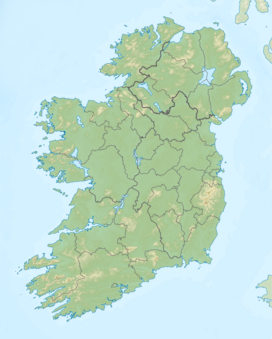Slieve Gullion
| Slieve Gullion | |
|---|---|
| Sliabh gCuillinn | |

Slieve Gullion from Aughanduff
|
|
| Highest point | |
| Elevation | 573 m (1,880 ft) |
| Prominence | 478 m (1,568 ft) |
| Listing | Marilyn |
| Coordinates | 54°08′N 6°26′W / 54.133°N 6.433°WCoordinates: 54°08′N 6°26′W / 54.133°N 6.433°W |
| Geography | |
| Location | County Armagh, Northern Ireland |
| Parent range | Ring of Gullion |
| OSI/OSNI grid | J024201 |
Slieve Gullion (from Irish: Sliabh gCuillinn, meaning "mountain of the steep slope" or Sliabh Cuilinn, "Culann's mountain") is a mountain in the south of County Armagh, Northern Ireland. The mountain is the heart of the Ring of Gullion and is the highest point in the county, with an elevation of 573 metres (1,880 ft). At the summit is a small lake and two ancient burial cairns, one of which is the highest surviving passage grave in Ireland. Slieve Gullion plays a prominent role in the mythology and history of the area and dominates the countryside around it, offering views of as far away as Antrim, Dublin Bay and Wicklow on a clear day.
Villages around Slieve Gullion include Drumintee, Mullaghbawn, Lislea, Forkhill and Meigh. The mountain gives its name to the surrounding countryside, and is the name of an electoral area within Newry and Mourne district council.
Slieve Gullion is the eroded remains of a Paleocene volcanic complex. It is surrounded by a ring dike known as the Ring of Gullion, a designated Area of Outstanding Natural Beauty (AONB). Slieve Gullion has been shaped by glaciation and exhibits a classic 'crag and tail' glacial feature. The 'tail', made up of glacial deposits, points south, ending at Drumintee. The geological formation was the first ring dike to be mapped, although its significance was not understood until similar structures had been described from Scotland. The rocks of the area are complex and have featured in international geological debate since the 1950s. The site has attracted geologists from all over the world and featured in a number of theories that have been put forward to explain the unusual rock relationships. Some of these theories have now become an accepted part of geological science.
...
Wikipedia

